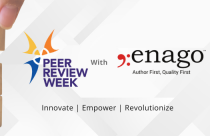Increasing Diversity and Inclusion in Peer Review

Although publication is a key to success in the academic world, the peer review process is not free from bias. Studies have shown that women and national minorities still face difficulties in getting published. Introducing diversity in the peer review process is one way to mitigate this type of bias. Today, we will examine ways to increase diversity among peer reviewers.
Why Does Peer Review Lack Diversity?
There are several drivers behind this lack of diversity in the peer review process. A study of the Frontiers journals examined whether gender bias was present in their review process. The study found that male editors chose more male peer reviewers while female editors chose more female peer reviewers. As the number of female editors was much smaller in comparison to male editors, fewer female peer reviewers were included overall.
Functional Ecology also performed a similar investigation of its peer review process and reached the same conclusions. The end result was less diversity in the peer review pool. This eventually translated to a lesser diversity of papers chosen for publication.
One explanation for this lack of diversity among peer reviewers is that academia and research are highly network dependent. People tend to form networks with their peers. Women still experience difficulty in advancing their careers and often the research they do is undervalued. National minorities face similar problems, and countries with fewer resources remain underrepresented in the peer review process. Because these groups face challenges in getting published and promoted, it is, therefore, less likely that they will be invited to peer review for journals.
Current Efforts to Increase Diversity
Increasing diversity and inclusion in peer review has become a hot-topic among journals and academic institutions. Here is what some journals are implementing to combat this problem.
- The American Geophysical Union (AGU) has instituted a policy to remind its editors to particularly focus on including women, young scientists, and minority reviewers.
- Conservation Biology is considering instituting double-blind peer review, which conceals the identities of both authors and reviewers.
- Four BMC journals: Trials, Systematic Reviews, Pilot and Feasibility Studies, and Journal of Medical Case Reports, have launched a pilot aimed at increasing the diversity of reviewers through a peer mentoring program. The program allows reviewers to recommend young researchers whom they would like to mentee through the process of peer review.
What Else Can be Done?
Authors and publishers are also offering suggestions to diversify the peer review process. Additionally, Functional Ecology also recommends that journals increase the gender, age, and geographic diversity of their editorial boards. Moreover, as data has shown, increasing diversity among editors will increase the diversity of the peer review pool.
Patricia M Knezek, chair of the committee on the status of women in astronomy at the American Astronomical Society, suggests that professional organizations should improve the representation of women and minorities as speakers, poster presenters, and participants at scientific meetings.
Jory Lerback, a former analyst at AGU who is now a research assistant at the University of Utah, US, says that more journalists and institutions should follow the lead of AGU. She also says that conducting an internal audit and being transparent with the results is the first step towards accountability and making a change.
Increasing diversity within peer review is a key step towards increasing the diversity of authors getting published. Eliminating bias in peer review will increase the visibility of important research among the public and enrich the scientific community.
Have you experienced any form of bias in peer review? Do you have some other ideas on increasing diversity in the peer review process? Tell us in the comments below.










